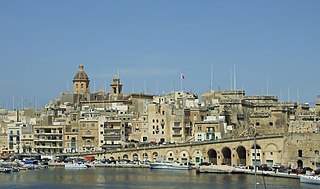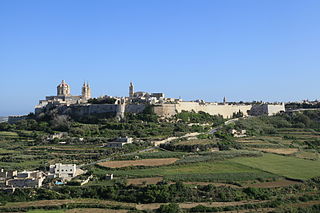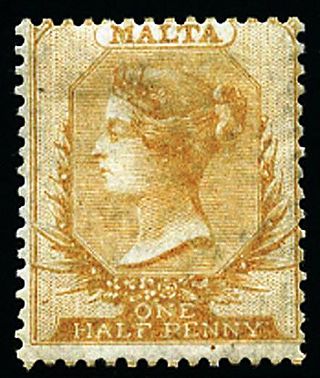
Valletta is the capital city of Malta and one of its 68 council areas. Located between the Grand Harbour to the east and Marsamxett Harbour to the west, its population as of 2021 was 5,157. As Malta’s capital city, it is a commercial centre for shopping, bars, dining, and café life. It is also the southernmost capital of Europe, and at just 0.61 square kilometres (0.24 sq mi), it is the European Union's smallest capital city.
A protectorate, in the context of international relations, is a state that is under protection by another state for defence against aggression and other violations of law. It is a dependent territory that enjoys autonomy over most of its internal affairs, while still recognizing the suzerainty of a more powerful sovereign state without being a possession. In exchange, the protectorate usually accepts specified obligations depending on the terms of their arrangement. Usually protectorates are established de jure by a treaty. Under certain conditions—as with Egypt under British rule (1882–1914)—a state can also be labelled as a de facto protectorate or a veiled protectorate.

Birgu, also known by its title Città Vittoriosa, is an old fortified city on the south side of the Grand Harbour in the South Eastern Region of Malta. The city occupies a promontory of land with Fort Saint Angelo at its head and the city of Cospicua at its base. Birgu is ideally situated for safe anchorage, and over time it has developed a very long history with maritime, mercantile and military activities.

Mdina, also known by its Italian epithets Città Vecchia and Città Notabile, is a fortified city in the Northern Region of Malta which served as the island's former capital, from antiquity to the medieval period. The city is still confined within its walls, and has a population of 250.

The Grandmaster's Palace, officially known as The Palace, is a palace in Valletta, Malta. It was built between the 16th and 18th centuries as the palace of the Grand Master of the Order of St. John, who ruled Malta from 1530 to 1798, and was also known as the Magisterial Palace. When the knights were expelled by Napoleonic France, it became the National Palace. During the period of British rule beginning in 1800, it was the Governor's Palace.

The Castellania, also known as the Castellania Palace, is a former courthouse and prison in Valletta, Malta that currently houses the country's health ministry. It was built by the Order of St. John between 1757 and 1760, on the site of an earlier courthouse which had been built in 1572.

The postal history of Malta began in the early modern period, when pre-adhesive mail was delivered to foreign destinations by privately owned ships for a fee. The earliest known letter from Malta, sent during the rule of the Order of St John, is dated 1532. The first formal postal service on the islands was established by the Order in 1708, with the post office being located at the Casa del Commun Tesoro in Valletta. The first postal markings on mail appeared later on in the 18th century.

The National Library of Malta, often known as the Bibliotheca, is a reference library in Republic Square, Valletta, Malta. It was founded by Grand Master Emmanuel de Rohan-Polduc in 1776 out of the collections of the knight Louis Guérin de Tencin. It has been a legal deposit library since 1925, and it has the largest collection of Melitensia along with that of the University of Malta. The library also contains the archives of the Order of St. John, the Università of Mdina and the Università of Valletta.

The Auberge de Castille, historically in full known as the Auberge de Castille et Portugal, is an auberge in Valletta, Malta. The auberge is located at Castile Place, close to Saint James Cavalier, the Malta Stock Exchange, and the Upper Barrakka Gardens. It sits at the highest point of Valletta and overlooks Floriana and the Grand Harbour area.

The Crown Colony of the Island of Malta and its Dependencies was the British colony in the Maltese islands, today the modern Republic of Malta. It was established when the Malta Protectorate was transformed into a British Crown colony in 1813, and this was confirmed by the Treaty of Paris in 1814. The colony gained independence in 1964.

The French occupation of Malta lasted from 1798 to 1800. It was established when the Order of Saint John surrendered to Napoleon Bonaparte following the French landing in June 1798. In Malta, the French established a constitutional tradition in Maltese history, granted free education for all, and theoretically established freedom of the press, although only the pro-French newspaper Journal de Malte was actually published during the occupation.

Hospitaller Malta, known in Maltese history as the Knights' Period, was a de facto state which existed between 1530 and 1798 when the Mediterranean islands of Malta and Gozo were ruled by the Order of St. John of Jerusalem. It was formally a vassal state of the Kingdom of Sicily, and it came into being when Emperor Charles V granted the islands as well as the city of Tripoli in modern Libya to the Order, following the latter's loss of Rhodes in 1522. Hospitaller Tripoli was lost to the Ottoman Empire in 1551, but an Ottoman attempt to take Malta in 1565 failed.

The Auberge de Bavière is a palace in Valletta, Malta. It was built as Palazzo Carneiro in 1696, and was the residence of Grand Master Marc'Antonio Zondadari in the early 18th century. In 1784, it was converted into the auberge for the Anglo-Bavarian langue of the Order of Saint John, and remained so until the French occupation of Malta in 1798.

The French invasion of Malta was the successful invasion of the islands of Malta and Gozo, then ruled by the Order of St. John, by the French First Republic led by Napoleon Bonaparte in June 1798 as part of the Mediterranean campaign of the French Revolutionary Wars.

The Malta Government Gazette is a government gazette published by the Department of Information of the Government of Malta. It was first published in 1813 when the islands were a British colony and it continued to be published after Malta became independent in 1964. Since then, the newspaper has been published in Maltese and English; previous editions were in Italian or a combination of some or all of the three languages. Since 2015 the gazette has been published in a digital-only format, and only a limited number of copies are printed for archival purposes.

The Journal de Malte was Malta's first newspaper, and it was published between July and September 1798 during the French occupation of Malta. Written in French and Italian, a total of ten issues of the newspaper are believed to have been published, although only seven seem to still survive today and it is unclear if the other three are lost or if they were ever actually published at all.
L'Argo was a newspaper published in the British protectorate of Malta in 1804. At the time of its issue, it was the only periodical publication in Malta. L'Argo was preceded by Foglio d'Avvisi (1803–1804) and it was succeeded by Il Cartaginese (1804–1805).

Il Cartaginese was a newspaper published in the British protectorate of Malta between 1804 and 1805. At the time of its issue, it was the only periodical publication in Malta. Il Cartaginese was preceded by L'Argo (1804) and it was succeeded by the Giornale di Malta (1812–1813).

The Giornale di Malta was a newspaper published in the British protectorate of Malta between 1812 and 1813. At the time of its issue, it was the only periodical publication in Malta. The Giornale di Malta was preceded by Il Cartaginese (1804–1805) and it was succeeded by Gazetta del Governo di Malta (1813–present).
Charles Frederick de Brocktorff was a German-Danish artist who is best-known for painting watercolours of Malta in the first half of the 19th century.

















